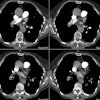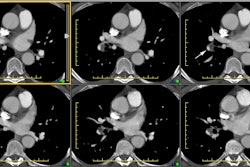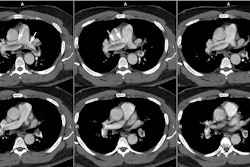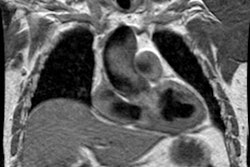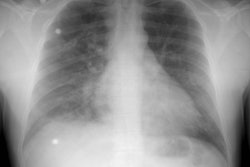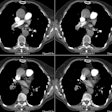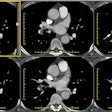Pulmonary Capillary Hemangiomatosis:
Clinical:
Pulmonary capillary hemangiomatosis (PCH) is a rare disorder that leads to pulmonary hypertension. Some authors consider PCH and pulmonary veno-occlusive disease (PVOD) to be different stages of the same disease (pathologic PVOD findings are found in 80% of PCH patients) [7]. Both disorders share the mutation of the EIF2AK4 gene (eukaryotic translation initiation factor 2 alpha kinase 4) located on chromosome 15, which could be responsible for the inherited PVOD and PCH with a recessive mode of transmission [7]. The gene codes for serine-threonine kinase, which induces changes in gene experssion in situations of amino acid deprivation, leading to a preferential synthesis of stress proteins [7]. This mutation is found in about 25% of sporadic cases of PVOD and PCH [7].There is proliferation of thin-walled alveolar capillaries throughout the interstitium which infiltrate the lung parenchyma, blood vessels, and bronchial tree. Most patients are children [3] or between the age of 20-40 years who present with dyspnea and hemoptysis (30% of patients). Hemorrhagic pleural effusions can be found in up to 25% of patients [5]. The disorder is often confused clinically with primary pulmonary hypertension (PPH), but hemoptysis is less common in PPH. There is usually a rapid deterioration with right heart failure and death within 3-5 years from onset of symptoms.
Lung biopsy is contraindicated and can be life threatening due to a high risk of hemorrhage [7].
Early diagnosis and bilateral lung transplant are the best hopes for a cure (there has not be a report of recurrent disease following transplant) [7]. As with PVOD, treatment with intravenous vasodilators used for pulmonary arterial hypertension (such as prostacyclin or calcium channel blockers) can be fatal due to pulmonary edema. Supportive treatment until transplant consists mainly of O2 administration to avoid worsening of the pulmonary hypertension due to hypoxemia pulmonary vasoconstriction [7]. High doses of diuretics are recommended to prevent pulmonary edema [7].
X-ray:
Plain film findings include evidence of pulmonary artery hypertension with enlarged central pulmonary arteries, but there is also a diffuse, bilateral reticulonodular pattern to the lung parenchyma. On HRCT, a mosaic attenuation pattern and widespread ill-defined centrilobular ground glass nodules [22] can be seen. In contrast to PVOD, septal lines and pleural effusions are seen only sporadically [5].REFERENCES:
(1) J Thorac Imag 1998; 13: 49-51
(2) AJR 1998; Dufour B, et al. High-resolution CT of the chest in four patients with pulmonary capillary hemangiomatosis or pulmonary venoocclusive disease. 171: 1321-1324
(3) Radiographics 2002; Engelke C, et al. High-resolution CT and CT angiography of peripheral pulmonary disorders. 22: 739-764
(4) Radiology 2002; Hansell DM, et al. Small-vessel diseases of the lung: CT-pathologic correlates. 225: 639-653
(5) Radiographics 2007; Pulmonary veno-occlusive disease and
pulmonary capillary hemangiomatosis. 27: 867-882
(6) Radiographics 2012; Pena E, et al. Pulmonary hypertension:
how
the radiologist can help. 32: 9-32
(7) Radiology 2020; Delhaye C, et al. Pulmonary veno-occlusive disease and pulmonary capillary hemangiomatosis. 295: 240-244
